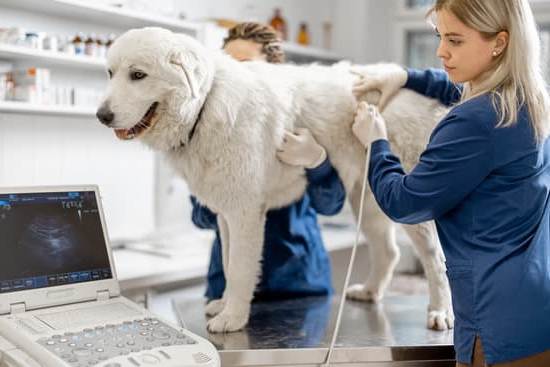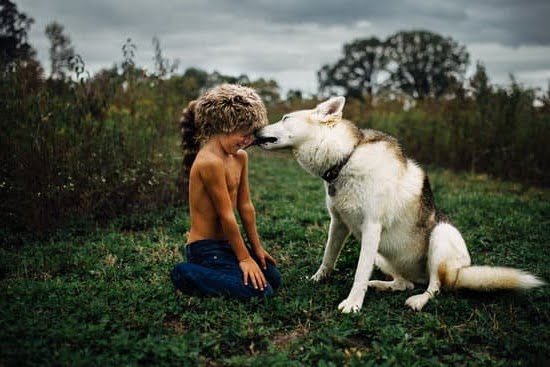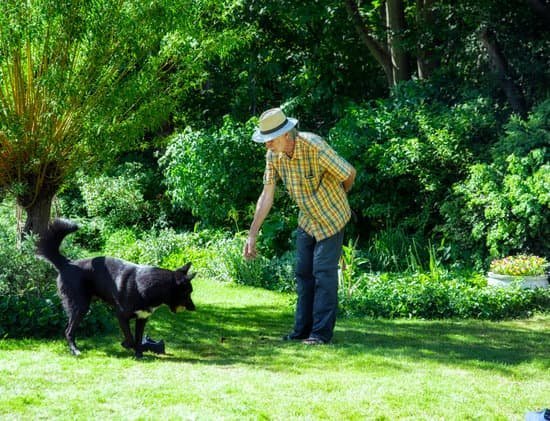Dogs have long been known as man’s best friend, but their loyalty and companionship extend far beyond just being a beloved pet. When properly trained, a dog can serve as a reliable protector, ensuring the safety of your family and property. Whether it’s fending off intruders or alerting you to potential dangers, a well-trained protection dog can be an invaluable asset in keeping your loved ones secure.
In this article, we will explore the essential steps and techniques involved in training a dog to protect your family. We will start by discussing the ideal dog breeds for family protection and the specific characteristics you should look for when selecting your four-legged guardian. Understanding these traits will help you choose a breed that is naturally inclined towards guarding and protecting.
Building a strong bond with your canine companion is fundamental to successful protection training. We will delve into establishing trust and loyalty as the foundation for protection training, emphasizing the importance of mutual respect between owner and dog. Additionally, we will cover basic obedience training techniques that will enable better control and communication with your dog in potentially dangerous situations.
By following this comprehensive guide, you will gain insight into how to prepare your dog to protect both inside and outside the home. From socialization exercises to advanced protection techniques, we will offer practical advice on developing your dog’s protective instincts and response to threats.
Stay tuned for an exploration of home defense strategies that focus on training your furry protector to guard your family and property within the household setting. We’ll also discuss personal protection outside the home, teaching your dog how to recognize danger and defend against potential threats while out in public or on walks.
Throughout this journey, we emphasize responsible ownership as paramount to ensuring safety for all. Proper supervision, ongoing reinforcement, and adherence to effective training principles are essential in maintaining a balanced and reliable protection dog.
Are you ready? Let’s embark on this exciting adventure of training your faithful canine companion to protect your family.
Understanding the ideal dog breeds for family protection
When it comes to training a dog to protect your family, selecting the right breed is crucial. Not all dogs are suitable for this role, as certain breeds possess inherent traits that make them better suited for guarding and protecting. Understanding the characteristics to look for in an ideal protection dog breed can help you make an informed decision.
Characteristics to Look For
There are several key characteristics to consider when choosing a dog breed for family protection. One of the most important traits is intelligence. A smart and trainable dog will be easier to work with during the training process. Loyalty is another essential quality, as you want a dog that will remain dedicated to their family and be willing to defend them if necessary.
Another characteristic to look for is size and strength. Larger breeds tend to have a more intimidating presence, which can serve as a deterrent to potential threats. Additionally, strong physical attributes are necessary for engaging in protective behaviors effectively.
Lastly, consider the temperament of the breed. Ideally, you want a dog that is naturally protective and has a stable temperament. A protective breed should be confident but not aggressive towards people without reason.
Breeds Suitable for Guarding and Protecting
Several breeds are known for their ability to excel in protection roles. German Shepherds are popular choices due to their intelligence, loyalty, and natural protective instincts. They are also highly trainable and versatile.
Doberman Pinschers are another breed commonly used for protection work due to their loyalty, strength, and trainability. Rottweilers also possess similar qualities, making them suitable candidates as well.
Other breeds like Belgian Malinois, Boxers, Bullmastiffs, and Doberman Pinschers may also exhibit excellent protective instincts if properly trained and socialized.
Remember that while certain breeds have innate characteristics that make them good protectors, individual temperament and genetic variations can still influence an individual dog’s suitability for protection work. It is important to thoroughly research and evaluate both the breed characteristics and individual dog’s temperament before deciding on your protection dog.
By understanding these ideal dog breeds for family protection, you can make an informed decision when selecting a new furry member to join your family and ensure that they possess the qualities necessary for successfully protecting your loved ones.
Building a strong bond
Establishing a strong bond with your dog is crucial when training them to protect your family. A solid foundation of trust and loyalty is essential in order to develop a reliable and obedient protection dog. Here are some key aspects to consider when building this bond:
Spend quality time together
Spending quality time with your dog is essential for developing a strong bond. This includes regular play sessions, walks, and simply relaxing together. Engaging in activities that you both enjoy will help build a positive association between you and create a sense of companionship.
Positive reinforcement
Positive reinforcement is an effective training method that rewards desired behavior with treats, praise, or affection. When using positive reinforcement techniques, it’s important to be consistent and timely in delivering rewards. This will reinforce the behaviors you want from your dog while also deepening their trust in you as their handler.
Consistency and clear communication
Consistency is key when establishing trust with your dog. Set clear boundaries and rules early on, and ensure that everyone in the household follows them consistently. Dogs thrive on routine, so maintaining a structured environment will help them feel secure and build their confidence.
Additionally, clear communication is vital for building trust. Dogs rely on body language and tone of voice to understand their handlers’ expectations. Use consistent verbal cues and hand signals during training sessions to convey commands clearly.
By investing time into building a strong bond with your dog through quality time, positive reinforcement, consistency, and clear communication, you will establish a solid foundation for protection training. Remember that building this bond requires patience, understanding, and dedication from both you and your furry companion. With this groundwork established, you can move onto teaching basic obedience commands as outlined in the next section to further enhance the relationship between you and your dog for protection training purposes.
Basic obedience training
Basic obedience training plays a crucial role in training a dog to protect your family. By teaching your dog essential commands, you establish better control and communication, which is vital during protective situations. This section will explore the importance of basic obedience training and provide examples of essential commands that every protection dog should know.
One of the first commands to teach your dog is “sit.” This command not only establishes obedience but also helps maintain control in potentially dangerous situations. For example, if your dog becomes too excited or aggressive, being able to command them to sit can help de-escalate the situation and regain control.
Another important command is “stay.” This command ensures that your dog remains in one place until instructed otherwise. In a protective scenario, it may be necessary for your dog to stay in a specific area while you assess the threat or take appropriate action. Additionally, “stay” can be useful when there are guests or visitors at your home, allowing you to control your dog’s behavior and prevent any unwanted incidents.
Furthermore, “heel” is a command that teaches your dog to walk calmly beside you without pulling or wandering off. This is particularly important during walks outside the home when you want your protection dog to stay close and attentive to potential threats. The ability to keep them focused on their handler builds better communication and enhances their ability to respond quickly when needed.
| Command | Description |
|---|---|
| Sit | Teaches the dog to sit down and wait for further instructions. |
| Stay | Instructs the dog to remain in one place until given permission. |
| Heel | Commands the dog to walk calmly and closely beside its handler. |
Basic obedience training forms the foundation of protection training for your dog. These commands provide you with better control and help establish clear communication between you and your dog, ensuring their ability to respond appropriately in protective situations.
Socialization
Socialization plays a crucial role in training a dog to protect your family. By exposing your dog to various people, environments, and situations, you can ensure that they develop the ability to discern friend from foe. This skill is essential for a protection dog, as it allows them to differentiate between potential threats and harmless individuals.
The process of socialization should begin at an early age. Introduce your puppy to different types of people, including men, women, children, and individuals wearing hats or uniforms. Encourage positive interactions with strangers by rewarding your dog with treats or praise when they display appropriate behavior. Gradually expose your dog to different environments such as parks, busy streets, and even crowded events like festivals or farmers markets.
It’s important to note that during socialization exercises, you should prioritize safety and control. Keep your dog on a leash if necessary and monitor their reactions closely. If your dog shows signs of fear or aggression towards anyone or anything during the socialization process, consult with a professional trainer who can help address these concerns and modify the training techniques accordingly.
Additionally, exposing your dog to different situations can also help in training them to handle real-life scenarios effectively. Expose them to common household sounds such as doorbells ringing or vacuum cleaners running. Consider enrolling them in obedience classes or joining training groups where they can interact with other dogs and learn how to behave in a group setting.
By focusing on socialization throughout your dog’s training journey, you are ensuring that they are not only capable of protecting your family but also able to navigate various environments confidently while distinguishing between actual threats and harmless individuals. It is an integral part of building a well-rounded protection dog that can effectively fulfill their role in keeping your family safe.
Advanced protection training techniques
In this section, we will explore advanced protection training techniques that can help develop your dog’s protective instincts and response to potential threats. These exercises and drills are designed to take your dog’s training to the next level, further honing their skills as a protector.
One effective technique is scenario-based training. This involves creating realistic situations in which your dog can practice their protective instincts. For example, you can have a family member act as an intruder or simulate a home invasion scenario. By rehearsing these scenarios, your dog will become more confident and better prepared to react appropriately in real-life situations.
Another important aspect of advanced protection training is bite work. This involves teaching your dog how to bite and release on command. It is crucial to work with a professional trainer who specializes in this area to ensure proper technique and safety for both you and your dog. Bite work not only enhances your dog’s ability to protect but also strengthens their self-control and responsiveness to commands.
Additionally, agility training can be beneficial for advanced protection training. Agility exercises such as obstacles courses, jumping over hurdles, or climbing ramps can help improve your dog’s physical fitness and agility. This allows them to navigate different terrains quickly and effectively while responding to potential threats.
To track the progress of your dog’s advanced protection training, keeping detailed records is essential. Document their achievements, areas for improvement, and any challenges they face during the process. Regular evaluations from a professional trainer will also help you identify areas that require more focus or modifications in your training approach.
Overall, advanced protection training techniques aim at refining your dog’s natural protective instincts by simulating real-life scenarios and enhancing their physical abilities. With consistent practice and guidance from experienced trainers, you can help develop a well-rounded protection dog capable of reacting swiftly and effectively to potential threats.
| Technique | Description |
|---|---|
| Scenario-based training | Create realistic situations to practice protective instincts and reactions. |
| Bite work | Teach your dog how to bite and release on command, enhancing protection skills and self-control. |
| Agility training | Improve physical fitness and agility for quick response to potential threats. |
| Record keeping | Detailed documentation of progress, achievements, and areas for improvement. |
Home defense
Training your dog to guard and protect your family and property within the household setting is a crucial aspect of their overall protection training. By teaching your dog how to defend your home, you not only enhance the safety of your loved ones but also create a strong deterrent for potential intruders. Here are some important steps to follow when training your dog for home defense:
- Recognizing threats: Start by teaching your dog how to recognize threatening behavior or unusual sounds within your home. Use commands like “watch” or “alert” to indicate that they should be on guard. Reward them with praise or treats when they respond appropriately, reinforcing the behavior.
- Establishing boundaries: Train your dog to understand the specific areas they should protect within your home, such as entrances or windows. This can be done through consistent repetition and reinforcement using commands like “guard” or “stay.” Practice scenarios where someone pretends to invade your space, allowing your dog to actively protect their designated area.
- Barking on command: Teach your dog to bark on command as a means of signaling danger or scaring away potential threats. Practice this command both inside and outside the home, gradually introducing distractions to simulate real-life situations they may encounter when protecting you and your family.
To facilitate effective training, consider utilizing these helpful tools:
- Dog protection suits or sleeves: These provide a safe way for trainers or family members to simulate an attack during drills without risking injury.
- Alarm systems and security cameras: These can help reinforce the idea of guarding the home by alerting you and providing visual feedback during training sessions.
- Reinforcement toys and treats: Use these as rewards for desired behaviors, encouraging positive associations with protective actions.
Remember, consistency is key in training a protection dog for home defense. Regular practice sessions and ongoing reinforcement will help solidify their knowledge and instincts over time. It’s essential to consult with professional trainers who specialize in protection dogs to ensure the safety and effectiveness of your training program.
Personal protection outside the home
Teaching your dog to recognize danger and defend against potential threats while out in public or on walks is an important aspect of training a dog for personal protection. This section will focus on the techniques and steps you can take to ensure that your dog is prepared to keep you safe outside of the home environment.
- Exposing your dog to different environments: It is vital to expose your dog to various places, people, and situations outside the home setting. This exposure helps them become familiar with different scenarios they may encounter while out in public or on walks. Take your dog for regular walks in different neighborhoods, parks, and busy areas so they can get used to different sounds, smells, and types of people.
- Desensitization and positive reinforcement: To prepare your dog for potential threats, it’s essential to desensitize them to common stimuli like loud noises, sudden movements, or unfamiliar individuals. Provide positive reinforcement when they remain calm or show protective behavior in response to these stimuli. This positive association will strengthen their ability to recognize danger and respond accordingly.
- Teach focused attention: Teach your dog the command for focused attention, such as “Watch me,” which signals them to pay attention solely to you. This command is useful in distracting situations or when you want your dog’s focus directed towards potential threats. Practice this command regularly during walks by rewarding them with treats or praise when they maintain eye contact with you while ignoring distractions.
- Alert barking: Train your dog to use their bark as a way of alerting you and deterring potential threats. Introduce them gradually to controlled situations where someone approaches unexpectedly but poses no real danger. Encourage their natural instinctual response by praising them for barking when someone approaches too quickly or aggressively.
- Controlled aggression training: Seek guidance from a professional trainer who specializes in personal protection if you desire advanced levels of protection training outside the home environment. This advanced training will involve teaching your dog controlled aggression, where they learn to discern between an actual threat and a non-threatening situation. The training should emphasize on-command release and recall, so you have complete control over your dog’s response.
Remember, while it is crucial to train your dog for personal protection outside the home, it is also important to follow local laws and regulations regarding dogs in public spaces. Always prioritize the safety of others around you and make sure that your dog is under control at all times. With proper training and ongoing reinforcement, your dog can become a valuable asset in keeping you safe while out in public or on walks.
Ensuring safety for all
Once you have successfully trained your dog in protection techniques, it is important to remember that responsible ownership is key to maintaining a balanced and reliable protection dog. Owning a protective breed comes with responsibility, as these dogs have strong instincts and require consistent guidance and reinforcement.
Proper supervision is crucial in ensuring the safety of both your family and others. While a well-trained protection dog can be an asset, it is essential to supervise their interactions with strangers or unfamiliar animals. This includes being mindful of their behavior when visitors enter your home or when encountering other dogs during walks. Proper supervision allows you to intervene if necessary and prevents any potential incidents from occurring.
In addition to responsible ownership and supervision, ongoing reinforcement is vital in maintaining the skills and behaviors your dog has learned. Consistent training sessions and practice drills will help reinforce their protective instincts, obedience commands, and response to potential threats. Regular training also strengthens the bond between you and your dog, further solidifying their loyalty and trust.
It is worth noting that while training your dog to protect your family can provide an added layer of security, it does not guarantee absolute safety. It is important to understand that dogs are living creatures with limitations, so reliance solely on them for protection may create a false sense of security.
Remember that even a well-trained protection dog may encounter situations where they are unsure or overwhelmed. Therefore, it remains imperative to prioritize the safety of yourself, your family, and others by implementing additional security measures such as secure fencing around your property or investing in an alarm system.
By practicing responsible ownership through proper supervision, ongoing reinforcement, and understanding the limitations of a protection dog, you can ensure the safety of everyone involved while enjoying the benefits of having a loyal companion who acts as an effective deterrent against potential threats.
Conclusion
In conclusion, training your dog to protect your family is an invaluable investment in both the safety and well-being of your loved ones. Throughout this article, we have explored the fundamental components of creating a reliable protection dog.
First and foremost, it is crucial to understand the ideal dog breeds for family protection. By selecting a breed with suitable characteristics for guarding and protecting, you are setting yourself up for success. Additionally, building a strong bond based on trust and loyalty forms a solid foundation for protection training.
Basic obedience training provides essential commands that enhance control and communication during protective situations. Furthermore, socialization ensures that your dog can discern friend from foe by exposing them to various people, environments, and situations.
Taking training to the next level involves advanced protection techniques that develop your dog’s protective instincts and response to potential threats. This includes both home defense training as well as personal protection outside the home.
However, it is important to emphasize responsible ownership throughout this process. Proper supervision and ongoing reinforcement will maintain a balanced and reliable protection dog.
Frequently Asked Questions
Can I train my dog to be a protection dog?
Yes, it is possible to train your dog to be a protection dog, but it requires consistent training, patience, and the right temperament of the dog. Not all dogs are suitable for protection training, so it’s important to choose a breed that has natural protective instincts and is trainable. Working breeds such as German Shepherds, Rottweilers, Doberman Pinschers, and Belgian Malinois are often used for protection work due to their intelligence, loyalty, and protective nature.
To train your dog as a protection dog, it’s recommended to work with a professional trainer experienced in this type of training. This ensures that your dog receives proper guidance in obedience training, bite work development, and understands the difference between real threats and everyday situations.
How do I train my dog to guard my house?
Training your dog to guard your house starts with teaching basic obedience commands such as sit, stay, come, and leave it. Once your dog has mastered these commands reliably, you can start introducing more specific guarding skills. Encourage your dog to bark on command by using a cue word or praising him when he barks naturally in response to various stimuli around the house.
Teaching him the “quiet” or “enough” command will also be necessary to make sure he stops barking when instructed. Additionally, socialize your dog well so that he can discern between visitors and potential threats without being aggressive towards everyone who approaches your property. It’s important to remember not to encourage aggressive behaviors toward people or other animals unless there is an immediate threat.
How do I train my dog to protect my children?
To train your dog to protect your children, it’s essential to start with a strong foundation of obedience training and socialization. Teach your dog basic commands like sit-stay and recall reliably before progressing into more advanced behaviors. Introduce positive associations between your children and the presence of treats or toys simultaneously so that the presence of your children becomes something positive for the dog instead of a trigger for aggression or anxiety. Gradually expose your dog to different scenarios involving your children, such as supervised playtime or mealtime, and reward calm and appropriate behavior.
Make sure your children also respect the dog’s boundaries and avoid any rough handling that could make the dog anxious or uncomfortable. It is crucial to supervise interactions between your dog and children at all times, maintaining a safe environment for everyone involved. If you have concerns or need guidance, it is advisable to consult with a professional dog trainer who has experience in working with families and can provide specific training tailored to your situation.

Welcome to the blog! I am a professional dog trainer and have been working with dogs for many years. In this blog, I will be discussing various topics related to dog training, including tips, tricks, and advice. I hope you find this information helpful and informative. Thanks for reading!





